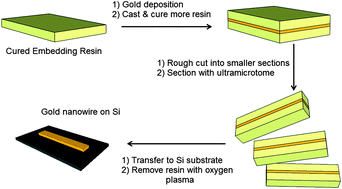This paper describes the characterization of new embedding resins for nanoskiving (ultramicrotomy) that contain thiols. Nanoskiving is a technique to produce nanoscale structures using an ultramicrotome to section thin films of materials (e.g., gold) embedded in polymer. Epoxies are used typically as embedding resins for microtomy. Epoxies, however, do not adhere well to gold or other smooth metallic structures that are used commonly for nanoskiving. Thiol–ene and thiol–epoxy polymers provide improved adhesion to gold due to the thiol functional group. In addition, the thiol–ene polymers can be prepared within minutes using photopolymerization, which allows for rapid prototyping. Two commercial thiol-containing adhesives were evaluated as resins in addition to several formulations of commercially available monomers. The important physical and mechanical properties for microtomy of these unconventional embedding resins were characterized and the properties were compared to commercial epoxy resins. Gold nanowires were fabricated using nanoskiving of gold films embedded in these unconventional resins. These studies show that a 3 : 4 mixture of thiol (pentaerythritol tetra(3-mercaptopropionate)) and ene (triallyl-1,3,5-triazine-2,4,6-trione) works very well as a resin for nanoskiving and provides improved adhesion and reduced preparation time relative to epoxies.

You have access to this article
 Please wait while we load your content...
Something went wrong. Try again?
Please wait while we load your content...
Something went wrong. Try again?


 Please wait while we load your content...
Please wait while we load your content...